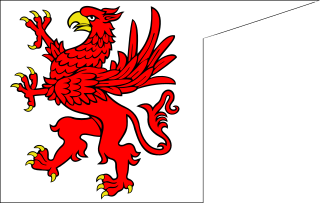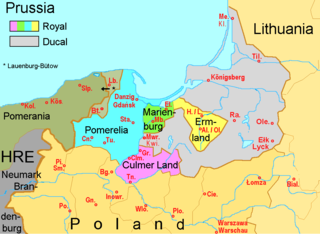
Brandenburg-Prussia is the historiographic denomination for the Early Modern realm of the Brandenburgian Hohenzollerns between 1618 and 1701. Based in the Electorate of Brandenburg, the main branch of the Hohenzollern intermarried with the branch ruling the Duchy of Prussia, and secured succession upon the latter's extinction in the male line in 1618. Another consequence of the intermarriage was the incorporation of the lower Rhenish principalities of Cleves, Mark and Ravensberg after the Treaty of Xanten in 1614.

The Duchy of Pomerania was a duchy in Pomerania on the southern coast of the Baltic Sea, ruled by dukes of the House of Pomerania (Griffins). The country had existed in the Middle Ages, in years 1121–1160, 1264–1295, 1478–1531 and 1625–1637.

Lauenburg and Bütow Land formed a historical region in eastern Pomerania. Composed of two districts centered on the towns of Lauenburg (Lębork) and Bütow (Bytów), it was on the western periphery of Pomerelia. The land is today part of the Polish Pomeranian Voivodeship.
The Uckermark is a historical region in northeastern Germany, currently straddles the Uckermark District of Brandenburg and the Vorpommern-Greifswald District of Mecklenburg-Vorpommern. Its traditional capital is Prenzlau.

Eric II or Erich II was a member of the House of Pomerania and was the ruling Duke of Pomerania-Wolgast from 1457 to 1474. He was the son of Wartislaw IX of Pomerania-Wolgast and Sophia, daughter of Eric IV of Saxe-Lauenburg.

Bogislaw X of Pomerania, the Great, was Duke of Pomerania from 1474 until his death in 1523.

The Treaty of Stettin of 4 May 1653 settled a dispute between Brandenburg and Sweden, who both claimed succession in the Duchy of Pomerania after the extinction of the local House of Pomerania during the Thirty Years' War. Brandenburg's claims were based on the Treaty of Grimnitz (1529), while Sweden's claims were based on the Treaty of Stettin (1630). The parties had agreed on a partition of the Swedish-held duchy in the Peace of Westphalia (1648), and with the Treaty of Stettin determined the actual border between the partitions. Western Pomerania became Swedish Pomerania, Farther Pomerania became Brandenburgian Pomerania.

The Treaty of Stettin or Alliance of Stettin was the legal framework for the occupation of the Duchy of Pomerania by the Swedish Empire during the Thirty Years' War. Concluded on 25 August (O.S.) or 4 September 1630 (N.S.), it was predated to 10 July (O.S.) or 20 July 1630 (N.S.), the date of the Swedish Landing. Sweden assumed military control, and used the Pomeranian bridgehead for campaigns into Central and Southern Germany. After the death of the last Pomeranian duke in 1637, forces of the Holy Roman Empire invaded Pomerania to enforce Brandenburg's claims on succession, but they were defeated by Sweden in the ensuing battles. Some of the Pomeranian nobility had changed sides and supported Brandenburg. By the end of the war, the treaty was superseded by the Peace of Westphalia (1648) and the subsequent Treaty of Stettin (1653), when Pomerania was partitioned into a western, Swedish part, and an eastern, Brandenburgian part.
Treaty of Prenzlau or Peace of Prenzlau may refer to several treaties during a series of wars between the Margraviate of Brandenburg and the Duchy of Pomerania fought for control of Pomerania-Stettin, and possession of the Uckermark in the 15th century. The First Peace of Prenzlau ended a war fought between 1445 and 1448, while the Second Peace of Prenzlau ended a war fought between 1466 and 1468. In older documents, Prenzlau may be spelled Prenzlow, which was the common spelling during the time period the treaties were drawn and was only changed during the 19th century. Prenzlau is situated in the center of Uckermark.

The Schlawe and Stolp Land, also known as Słupsk and Sławno Land, is a historical region in Pomerania, centered on the towns of Sławno (Schlawe) and Słupsk (Stolp) in Farther Pomerania, in present-day Poland.

Pomerania during the Late Middle Ages covers the history of Pomerania in the 14th and 15th centuries.

Pomerania during the Early Modern Age covers the history of Pomerania in the 16th, 17th, and 18th centuries.

Pomerania-Stolp was one of the partitions of the Duchy of Pomerania. Centred in Słupsk, it was created from another partition of the Duchy of Pomerania, Pomerania-Wolgast, to satisfy Bogislaw V, Duke of Pomerania in 1368, and existed until 1459, when it was inherited by Eric II of Pomerania-Wolgast. In 1474, it was merged to the partition of Bogislaw X, Duke of Pomerania, who four years later became the sole duke of Pomerania.
The Treaty of Soldin was signed on 21 January 1466 at Soldin by the Brandenburgian elector Frederick II and the Pomeranian dukes Eric II and Wartislaw X. It was mediated by the town of Stettin. The treaty temporarily settled a conflict about the succession of Otto III, Duke of Pomerania, who had died without issue: Emperor Frederick III, elector Frederick II as well as Eric II and Wartislaw X of Pomerania claimed to be the rightful heir of Otto's share of the Duchy of Pomerania.
Starting in the 12th century, the Margraviate, later Electorate, of Brandenburg was in conflict with the neighboring Duchy of Pomerania over frontier territories claimed by them both, and over the status of the Pomeranian duchy, which Brandenburg claimed as a fief, whereas Pomerania claimed Imperial immediacy. The conflict frequently turned into open war, and despite occasional success, none of the parties prevailed permanently until the House of Pomerania died out in 1637. Brandenburg would by then have naturally have prevailed, but this was hindered by the contemporary Swedish occupation of Pomerania, and the conflict continued between Sweden and Brandenburg-Prussia until 1815, when Prussia incorporated Swedish Pomerania into her Province of Pomerania.

The Treaty of Grimnitz was the final settlement of a long-standing dispute between the House of Pomerania and the House of Hohenzollern regarding the legal status and succession in the Duchy of Pomerania. It renewed and amended the Treaty of Pyritz of 1493.

George I of Pomerania was a Duke of Pomerania from the House of Griffins.

Duke Wartislaw X of Pomerania was the second son of Duke Wartislaw IX of Pomerania and his wife, Sophia of Saxe-Lauenburg.
The War of the Succession of Stettin was a conflict between the Dukes of Pomerania and the Elector of Brandenburg. It started in 1464, after the death of Duke Otto III, the last Duke of Pomerania-Stettin. The Dukes of Pomerania-Wolgast, Eric II and Wartislaw X, held that they were Otto's rightful heirs. Elector Frederick II of Brandenburg held that Pomerania-Stettin was a fief of Brandenburg. Since its duke, Otto III, had died without a male heir, it should fall back to Brandenburg.














